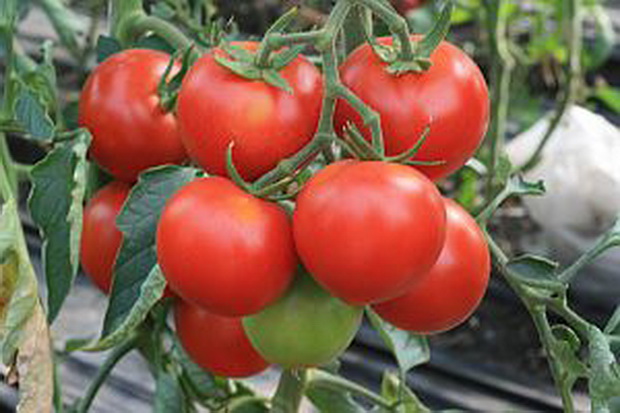 The seeds of the Dutch company Nunhems® are known to gardeners in many countries, and Russia is no exception. The quality of the seed material and the compliance of the characteristics of vegetables with real results has been proven in practice.
The seeds of the Dutch company Nunhems® are known to gardeners in many countries, and Russia is no exception. The quality of the seed material and the compliance of the characteristics of vegetables with real results has been proven in practice.
Donald F1 tomato hybrid stands out by early ripening, good yield. It is recommended for cultivation on farms, as it is suitable for mechanized harvesting.
Content
Description of the Donald Tomato Hybrid
The hybrid belongs to the group of not just early, but ultra-early tomatoes, so it can be grown in regions of risky farming. In the south, the hybrid grows well in open ground, in the middle lane, as well as in the Urals, Siberia, and regions of the North-West. It is recommended to cultivate the tomato under shelters.
The bush is compact, medium leaf. Usually the height of the plant does not exceed half a meter. Leaves of the usual form, saturated green. Fruits are round-oval in shape, formed in the hands. The average weight of tomatoes is about 50 grams; in one cluster, up to 5-6 fruits ripen.
The peel, like the pulp, is dense, but not stiff. Inside there are several chambers, few seeds. The fruits have a good taste, a pleasant aroma. Tomato is suitable for whole canning, and for fresh use. You can make juices, pasta, lecho, ketchups.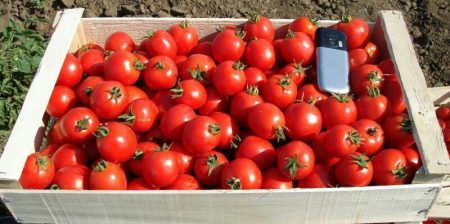
The hybrid retains all its palatability even after heat treatment. This tomato is delicious in salting, marinades. Assorted preserves look beautiful, while the fruits in jars with pickle or marinade do not crack.
Donald is a recumbent tomato, also suitable for long-term transportation. It does not lose commercial qualities; it retains its taste for a long time. This makes it particularly attractive for growing on various farms for sale.
Tomato Donald F1: Benefits
Tomatoes from Dutch producers are quite popular among Russian gardeners and farmers. Donald is a new generation hybrid that combines productivity, disease resistance, and unpretentiousness.
It should also be noted:
- ultra-precocity of tomato;
- compact sizes of bushes, which allows you to mix the required number of plants in limited areas;
- universality of the use of fruits;
- friendly return of the crop;
- excellent taste.
For industrial tomatoes, important qualities are fruit uniformity, color saturation, and suitability of tomatoes for harvesting using technology. Hybrid Donald fully meets these requirements, not without reason it is increasingly chosen for cultivation in large farms. This tomato will also please ordinary gardeners who like to grow carpal tomatoes.
Of the shortcomings, it should be noted that Donald is a hybrid, and, as you know, seeds from them are not collected for sowing. If you want to grow this tomato, you will need to purchase seeds before each season.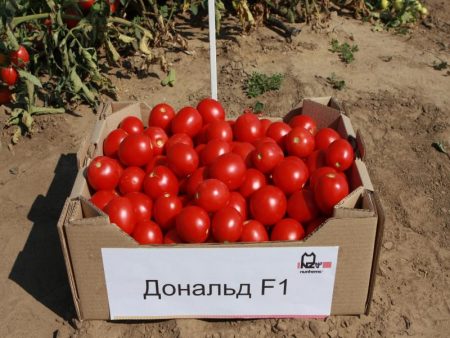
Agrotechnics: what you should pay attention to
The heat-loving culture is grown by seedling, sowing seeds immediately practiced only in the south of the country. This hybrid is characterized by very early ripening, so it is quite suitable for the northern regions.
Growing seedlings
Planting on ridges or in a greenhouse is carried out when the seedlings are about 45 days old. At the same time take into account:
- climate of the area;
- growing conditions (planted on ridges later, earlier in greenhouses);
- weather.
Spring can be early, prolonged, all this is already taken into account in the process of growing seedlings. It is optimal to plant tomatoes in the ground when the soil warms up to + 14ºC ... + 16ºC.
Based on this, determine the timing of sowing seeds, adding about 5-7 days for germination. Tomatoes are usually sown at the end of March, having previously prepared containers for seedlings and soil.
The seeds of the Dutch hybrid are processed by the manufacturer, so Donald F1 does not need any additional pre-sowing preparation. As a nutrient mixture, you can either take ready-made purchased soils, or prepare all the necessary components from autumn and spring to make the mixture yourself.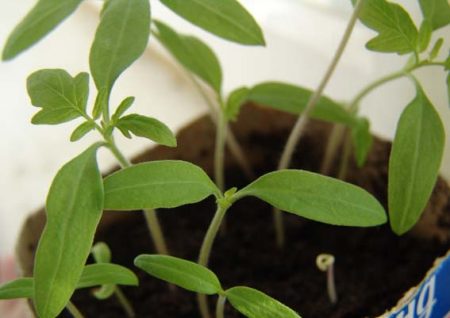
The soil should be loose, nutritious, without weeds, any impurities. It is heated, disinfected with a solution of potassium permanganate, allowed to stand for about two to three days, and then fertilizers are added:
- wood ash (one spoon will be enough for a bucket of the mixture);
- superphosphate (one teaspoon).
For growing tomatoes, wooden or plastic boxes, containers, cups (plastic, peat, paper) are suitable. First, seeds can be sown in common containers, then they pick, transplanting seedlings into larger pots. This culture easily tolerates transplantation, in addition, picking allows you to slightly delay the extension of seedlings.
Sow seeds in grooves, sprinkling them lightly with soil. The containers are cleaned in a warm place (+ 24ºC ... + 25ºC) and check the seedlings. As soon as the first sprouts appear, seedlings are exposed.
It is recommended to lower the temperature to + 18ºC for 5-6 days so that the thin sprouts do not stretch and grow stronger. Then establish a stable mode + 22ºC ... + 24ºC. The temperature may be slightly lower at night. Watering is limited, only on the soil. You can use a syringe for watering.
Have your tomatoes got 2-3 real leaflets? This means that it is time for seedlings to pee in pots, and then for a couple of days to shade seedlings from the rays of the sun. Watered regularly, as the soil dries up, avoiding excess moisture.
If the soil in the pots was well fertilized, then fertilizing for tomato seedlings can be omitted. If the growth is not good enough, they introduce complex fertilizer for feeding or water the seedlings of Kemira.
Planting Tomatoes and Care
When warm days (May or early June), seedlings are transplanted to a permanent place. It is recommended that before this time, harden the tomatoes for 10 days, taking them out to fresh air.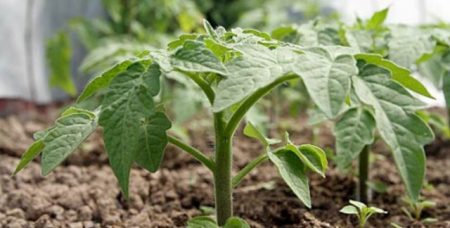
For tomatoes, sunny areas are chosen; for open ground, the absence of drafts is important. Best predecessors:
- cabbage;
- legumes;
- beet.
It is advisable not to grow tomatoes every year in one place, but if this is not possible, it is necessary to use green manure for cultivation of soil and disinfection.
They prepare the soil in the fall, introducing rotten manure, and in the spring - phosphate and potash fertilizers. The acidity index should be neutral; on acid and alkaline soils, tomatoes grow poorly.
Planting scheme: 3-4 plants per square meter. Tomatoes are planted in holes, spilling them with water and adding a little ash. For the first time, the planted seedlings are covered with non-woven material: to protect against cold snap, from the rays of the sun. Tomatoes are covered on the ridge, and those that have been planted in the greenhouse.
About 4-6 days after planting, the plants are not watered. You can mulch: peat, humus, hay, straw. Donald's short bushes do not need support, but during the ripening period you can put pegs and tie up some very large brushes.
Watering
When growing on ridges, irrigation is carried out taking into account precipitation. Tomatoes love plentiful, but rare watering, and this feature must be taken into account. Water should be warm (+ 20ºC), settled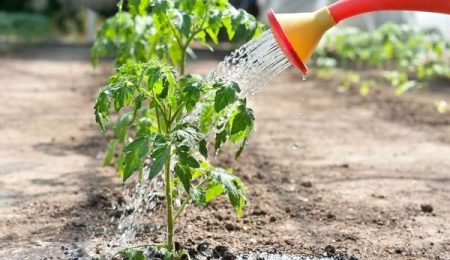
During fruiting, the number of irrigations is reduced; three weeks before harvesting, they are completely stopped. An excess of moisture in the soil during the ripening of tomatoes leads to the formation of watery pulp in the fruit. Also, excess moisture is often the cause of various infections.
Hybrid Feeding
Any hybrids require a good and balanced diet. Often gardeners complain that the tomato did not live up to their expectations, and the indicators given in the description of the variety or hybrid were not confirmed. It must be remembered that hybrids are special tomatoes, and their nutrition requires attention. In the first period of vegetation, plants are fed with organic matter (bird droppings or bred mullens are suitable), tomatoes need phosphorus before flowering, and potassium during fruiting.
Nitrogen cannot be abused, otherwise your tomatoes will “fatten”. Compact bushes will have powerful foliage, with few ovaries. If this is observed, it is urgent to feed the leaves with superphosphate (take two spoons on a bucket).
The very first feeding is carried out approximately three weeks after planting, then fertilizers are already applied every two weeks. The hybrid responds well to feeding green “lunch” - an infusion of herbs. To do this, chopped nettle leaves are loaded into a barrel or tank (other weed herbs can be used), top up the container with warm water, close tightly and leave for 5-6 days. After this, the infusion is used for irrigation, diluting it with water (per liter of water - a liter of infusion).
Also, many gardeners use ashes for feeding, making infusions and watering under the root, spraying leaves, dusting the soil with dry ash. It helps to fight against pests of tomatoes, and with various diseases.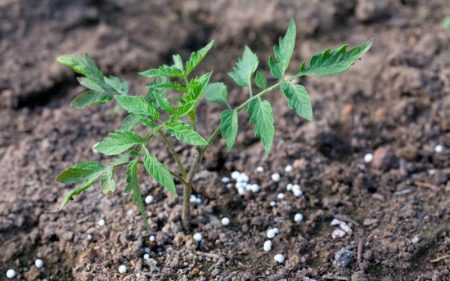
Tomato formation
The compact bushes of the Donald hybrid do not need pinching and shaping. If necessary, tomatoes grown in a greenhouse can remove the lower leaves to the first brush.
Harvesting tomatoes
The fruits are harvested when they reach technical ripeness (first brushes), then, subject to good warm weather, you can leave the tomatoes to ripen on the bush. Harvesting green tomatoes allows the plant to direct its strength and nutrition to the formation of fruits in the following brushes, thereby increasing the overall yield.
Donald F1 tolerates storage for up to several weeks (subject to harvesting at the stage of technical maturity), suitable for transportation. For ripening, the fruits are laid out in boxes or boxes.
Reviews of gardeners
Alena, Belgorod
I decided to try to grow a tomato hybrid from Holland. Donald attracted attention with his description, especially suitable for whole canning. It was grown in open ground, the height was 60 cm. The fruits are very dense, oval such, the taste is ordinary, tomato. I had a small yield, on the whole I would like a tomato for a solid "4".
Sophia, Moscow Region
I grow tomatoes for a long time, I prefer varieties for my family (after all, their taste is better), but for the sale I take hybrids. The Dutch simply grow well, always fruitful, and the fruits are even. They differ in commercial qualities, keeping quality is better, I keep them in the refrigerator for several weeks - nothing is done. But the taste is ordinary, normal, but the varieties in this regard have more variety. Donald is in my favorites, picking good crops from him, and two more Dutch hybrids. Early production goes well on the market, and the costs pay off, and there is a small profit too.
Ivan, Arkhangelsk region
Hybrid Donald was advised by a friend, they say, capricious and fruitful. Planted 6 bushes in the greenhouse, the fruits began to ripen early. Bushes about 50 cm, there were few leaves.It tastes nothing special, but we ate fresh these tomatoes a little. Wife rolled up in banks, it’s convenient that you can make large and half-liter rolls. Delicious in marinade, in pickling, the taste is not special.




 Low-growing tomatoes, without pinching: 5 of the most delicious varieties
Low-growing tomatoes, without pinching: 5 of the most delicious varieties Why tomato seedlings grow poorly
Why tomato seedlings grow poorly We grow a tomato in a shell
We grow a tomato in a shell Growing tomatoes without watering according to the method of Kazarin
Growing tomatoes without watering according to the method of Kazarin